
THE AIRLINE PILOTS FORUM & RESOURCE
TCAS Traffic Display |
| by John Law & Eurocontrol Specialists -- Source: PIA Flight Safety Publication |
 |
TCAS II (Traffic Alert and Collision Avoidance System) is a last resort safety net designed to prevent mid-air collisions. When it computes a risk of collision the system alerts the flight crew and provides instructions to resolve conflicting paths (resolution advisories, or RAs).
The main purpose of the TCAS II traffic display is to help flight to visually locate aircraft in the vicinity. Unfortunately some flight crew are tempted to make their own traffic assessment based on the TCAS display, and to manoeuvre ahead of ATC instructions. This can be dangerous as the TCAS II traffic display is easy to misinterpret. That is because the display gives you only partial information, has limited accuracy, and is based upon a moving reference.
A run through some actual events where problems have occurred due to misinterpretation of the TCAS II traffic display illustrates the nature of the problem.
Loss of Separation: The first event involved a loss of separation as a result of an inappropriate turn. A B767 (heading 100 degrees) and a MD80 (heading 217 degrees) were maintaining FL290 on crossing tracks.
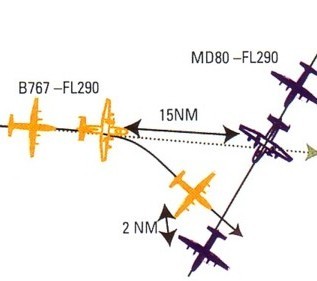
The B767 would have passed about 15 nm behind the MD80 (see dotted line on figure above). For radar separation, when they were still 80 nm apart, the controller instructed both aircraft to maintain their headings.
One minute before the tracks would have crossed, the controller gave traffic information to the B767 pilot: "Eleven o'clock, from left to right, same level, aircraft type MD80...25 nm, converging".
The B767 pilot started to monitor a target, which was on the left-hand side of the TCAS traffic display. As he assessed that the other traffic was converging head-on, the B767 pilot asked: "Where is this twelve o'clock traffic going?" The controller responded with updated traffic information.
However, the B767 pilot then said: "We're going to take a heading here of 120 degrees while starting a turn to the right." Due to this turn - in the wrong direction - the horizontal separation reduced quickly and a traffic alert (TA) was triggered on both aircraft. The B767 pilot started to descend and said, "We'd like to go to [FL] 270". Afterwards, to justify his decision to turn, the B767 pilot told the controller that "the traffic was coming right up, so we [turned] to avoid the traffic".
The inappropriate turn reduced separation to only 2 nm. Why did the B767 pilot to turn contrary to the ATC instruction? And why to the right? The following figures show how the situation was shown on the controller's radar display and on the B767 TCAS traffic display at the time of the initial traffic information.
| B767 TCAS Traffic Dispaly | Controller's Radar Display |
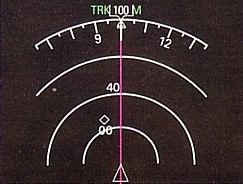
|
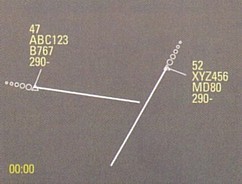
|
On the controller's display, the 3-minute speed vector (magnetic track and speed) clearly showed that the B767 was going to pass behind the MD80 (which was faster - 520 kt ground speed for the B767 versus 470 kt ground speed for the MD80). But this was not obvious on the TCAS traffic display.
The B767 pilot was misled because of the difficulty involved in anticipating how the situation would evolve solely from the information presented on the TCAS traffic display. The B767 pilot related a target on the TCAS traffic display to the initial traffic information. What the B767 pilot saw was a target moving apparently on opposite track, slightly on the left. Hence his question to the controller: "Where is this 12 o'clock traffic going?"
When the target was at the 12 o'clock position and less than 20 nm, the B767 pilot decided to turn right to avoid the target on the TCAS traffic display ("We're going to take a heading 120" - see figures below).
| B767 TCAS Traffic Dispaly | Controller's Radar Display |
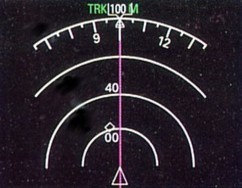
|
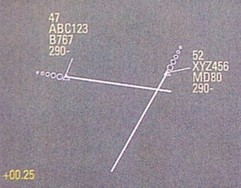
|
The pilot was unable to relate the direction of the traffic in the controller's traffic announcement to the information provided by the TCAS traffic display, so he did not take it into account. But to the controller, it was obvious that the turn to the right would create a loss of separation. Because of the turn to the right, the target remained on the left-hand side on the TCAS traffic display, apparently still on opposite track, and a TA was then triggered. The pilot then decided to descend ("We'd like to go to 270" - see figures below). A loss of separation then occurred.
| B767 TCAS Traffic Dispaly | Controller's Radar Display |
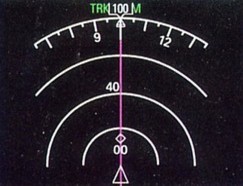
|
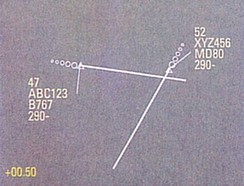
|
| B767 TCAS Traffic Dispaly | Controller's Radar Display |
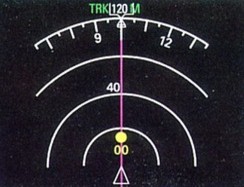
|
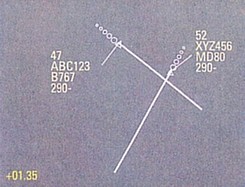
|
Challenge to ATC Instruction: In the second event a B747 pilot challenged an ATC turn instruction for separation. A DC10 (heading 100 degrees) and a B747 (heading 040 degrees) were level at FL350 - and on a collision course.
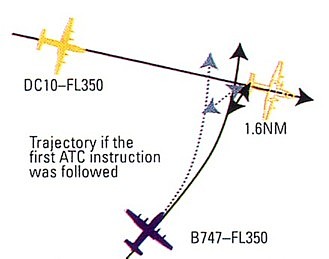
Two and a half minutes before the crossing, the controller instructed the B747 pilot to turn 30 degrees left to achieve a separation of 5 nm behind the DC10. However, the B747 pilot saw a target on the left at the same level on his TCAS traffic display. He asked the controller, "Confirm 30 degrees left?" He thought - wrongly - that a left turn (which would actually have resolved the situation) would have created a collision risk.
| TCAS Traffic Display of B747 | Confirm 30 Degrees Left? |
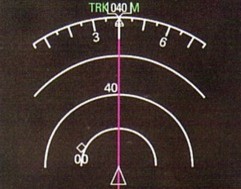
|
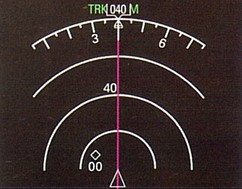
|
Thirty seconds later the B747 pilot said, "If we turn 30 degrees left, we will be aiming towards another aircraft at our level." Meanwhile a short-term conflict alert was triggered and the controller instructed the DC10 to descend.
The controller then provided traffic information to the B747 pilot who asked: "Which heading would you like us to take?" The controller repeated his instruction to "turn left 30 degrees". This time, the B747 pilot accepted the instruction and initiated a left turn, but it is too late to maintain separation.
The B747 pilot reported a "TCAS Advisory". The minimum distance reached was 1.6 nm. Later the B747 pilot asked the controller to explain the reason for the turn. The controller replied that there was conflicting traffic at the same level. The B747 pilot answered: "We are filing [a report] ... you sent us straight [towards] the aircraft".
Analysis of the incident confirmed that if the B747 pilot had complied with the initial ATC instruction to turn, a 5 nm horizontal separation would have been achieved (see the dotted line on the figure above).
There are three factors which contribute to traffic display misinterpretation:
- Nature of the TCAS moving reference display.
- Partial traffic picture given by the system.
- Limited accuracy of TCAS bearing information.
Moving Reference: The reference for the TCAS traffic display is the aircraft's own position, which is constantly moving (unlike the controller's radar display, which has a fixed reference). This gives a display where the targets are shown in relative motion, a major cause of TCAS traffic display misinterpretation. The most significant illustration of this is when two aircraft are converging at 90 degrees. Following figures show that the symbol of an aircraft on a 90 degree crossing track actually appears to be converging at a 45° angle on the TCAS traffic display.
| Aircraft Trajectories Converge at 90° | Closure Appears to be at 45° on TCAS |
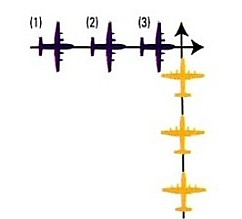
|
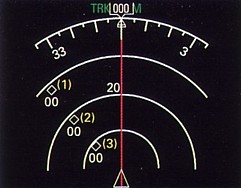
|
The same issue occurs when an aircraft is catching up on a slower aircraft flying in the same direction. In this situation, the target is apparently displayed as an intruder on an opposite direction track.
The interpretation of an intruder trajectory on the TCAS traffic display is even more difficult when the aircraft is manoeuvring because the bearing of the intruder will vary significantly even if its heading is steady.
In addition, the lack of either a speed vector or knowledge of the intent of the other aircraft can make it more difficult to interpret the TCAS traffic display. It is also hard to work out in advance if you are on a collision course or whether separation will be maintained. For example, when an extended range is selected, the size of the target symbol can be large, corresponding to a few nautical miles. Therefore, the TCAS display is much less precise than the controller's radar display.
Partial Traffic Picture: Although the TCAS traffic display helps pilots to detect the presence of intruders in close vicinity, flight crews should not be over-reliant on the display. It supports visual acquisition; it is not a replacement for the out-of-window scan. One of the main reasons for this is that the traffic picture provided by the TCAS traffic display is only partial. TCAS only detects intruders with an active transponder, and does not provide traffic identity information.
So there can be aircraft in the vicinity even if there is no target on the TCAS traffic display. As a result flight crews can get a wrong idea of their traffic situation. Two recent events illustrate the potential problem.
A controller advised a pilot approaching his cleared flight level that further descent would be after 4 nm due to traffic. The pilot answered: "We have him on TCAS". However, he misidentified the target because the actual conflicting aircraft had a transponder failure; it was shown to the controller on primary radar only.
In another incident, a pilot reported that a TCAS technical fault displayed an intruder in descent whereas he could see a climbing fighter. Actually, TCAS operated perfectly: there were two fighters, the one descending was transponding but the one climbing was not.
TCAS surveillance range may be reduced to 5 nm in high density airspace. Therefore, pilots could observe aircraft in the vicinity, which might not be shown on the TCAS traffic display.
Even if aircraft are detected by TCAS, they may not be displayed. Some installations limit the number of displayed targets to a maximum of eight. In addition, the TCAS traffic display options provide altitude filtering (for example, "NORMAL" mode only shows targets within +/- 2700 ft from the aircraft).
Limited Accuracy: The TCAS II bearing measurement is not very accurate. Usually, the error is no more than 5 degrees but it can be greater than 30 degrees. Due to these errors the target symbol on the display can jump.
Following figures show the TCAS traffic displays of an event recorded during a TCAS II trial. There were 3 intruder aircraft, in the 12 o.clock position, but separated by 500 ft vertically. However, the intruder at +05 (500 ft above) appears at 6 seconds interval, on the right of the group of targets (fig 1) and then on the left (fig 2), before being shown in the correct 12 o'clock position (fig 3).
| Fig 1 | Fig 2 | Fig 3 |
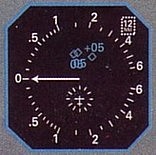
|
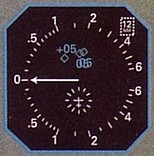
|
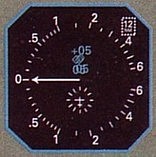
|
In the worst case, bearing error could cause a target on one side of the aircraft to be displayed on the other. This emphasises the danger of undertaking a horizontal manoeuvre based solely on the TCAS traffic display. Note that TCAS II does not need bearing information for collision avoidance RAs.
Manoeuvres initiated solely on the information shown on the TCAS traffic display have often degraded flight safety. Therefore, pilots should not attempt, to self-separate, nor to challenge an ATC instruction, based on information derived solely from the TCAS traffic display. It is the controller's responsibility to separate aircraft.
TCAS II will trigger an RA if there is a risk of collision between aircraft, and in this case the TCAS RA should be followed.
Rules for use of TCAS Display:
ICAO PANS-OPS, Doc 8168 states: "Pilots shall not manoeuvre their aircraft in response to traffic advisories (TAs) only".
This point is emphasised in the ICAO ACAS II (Airborne Collision Avoidance System) training guidelines for pilots: "No manoeuvres are made based solely on the information shown on the ACAS display".
ICAO standards only include phraseology to report resolution advisories (RAs). Therefore, pilots should not report, "TCAS Contact" or "We have it on TCAS" after traffic information from ATC. Indeed, such a report provides no added value to ATC.
Note that in the event of a conflict of advice between a TCAS RA and an ATC instruction, the TCAS RA should be followed.
[John Law is Mode S and ACAS program manager, Eurocontrol]

